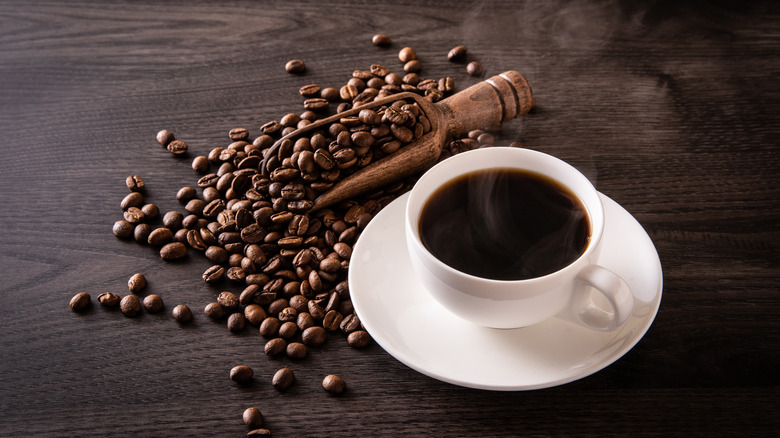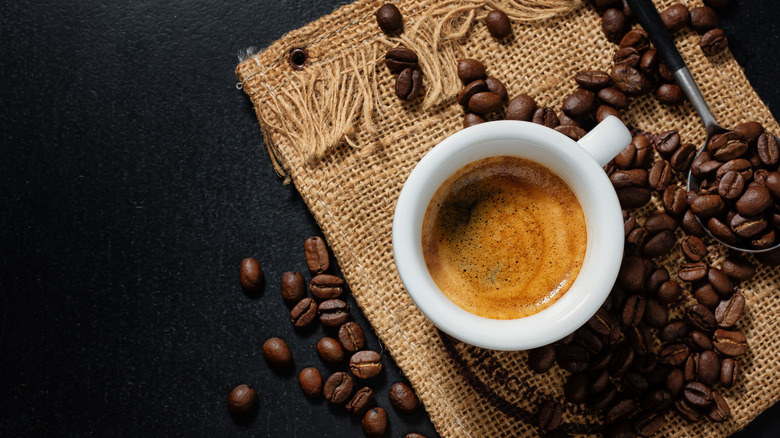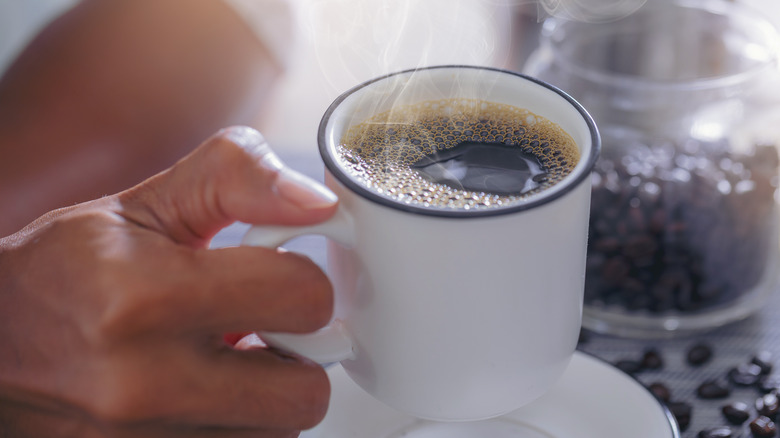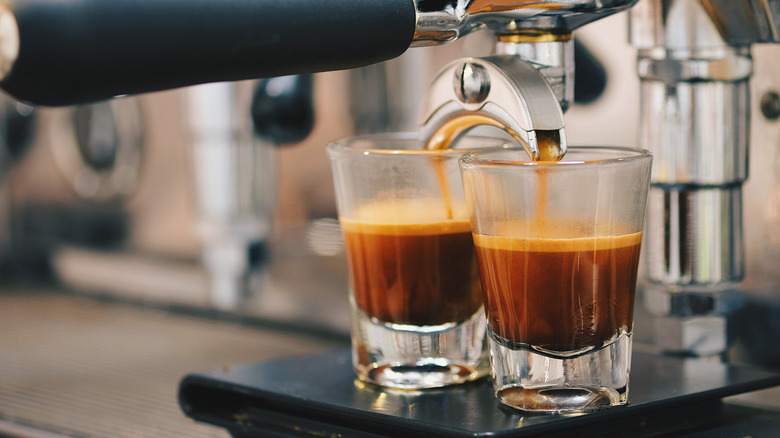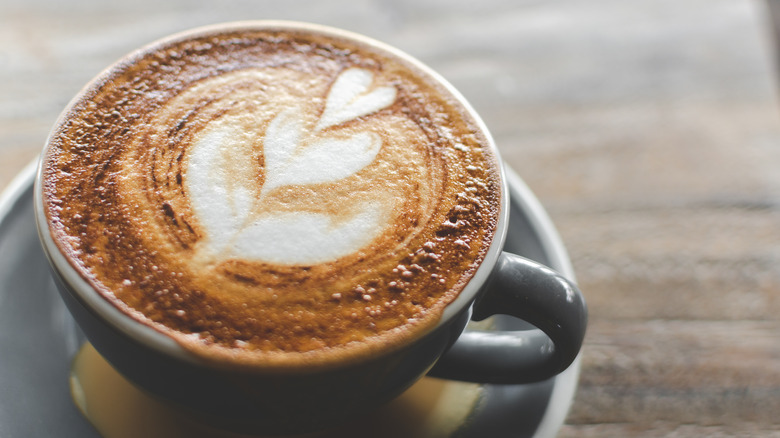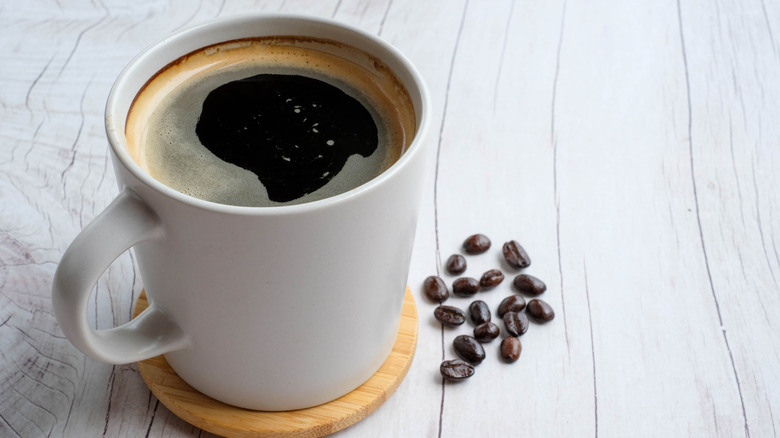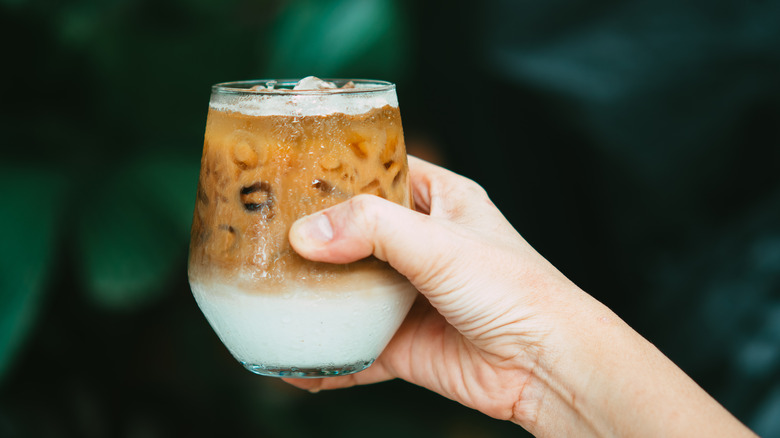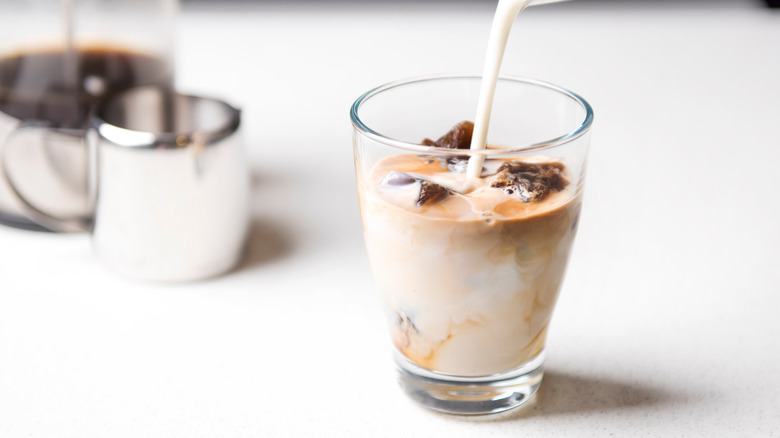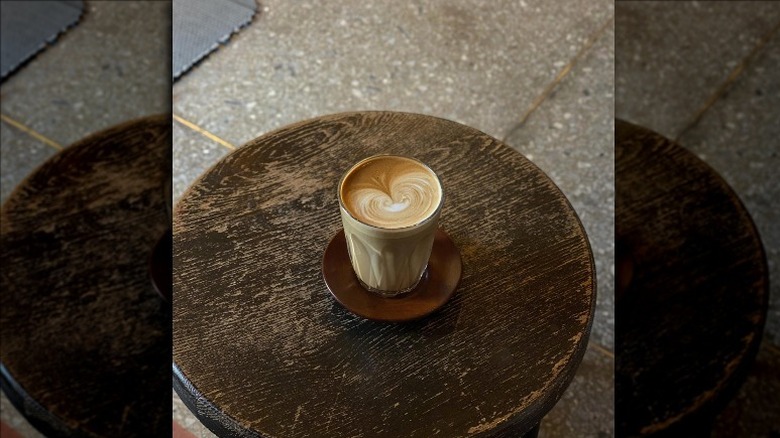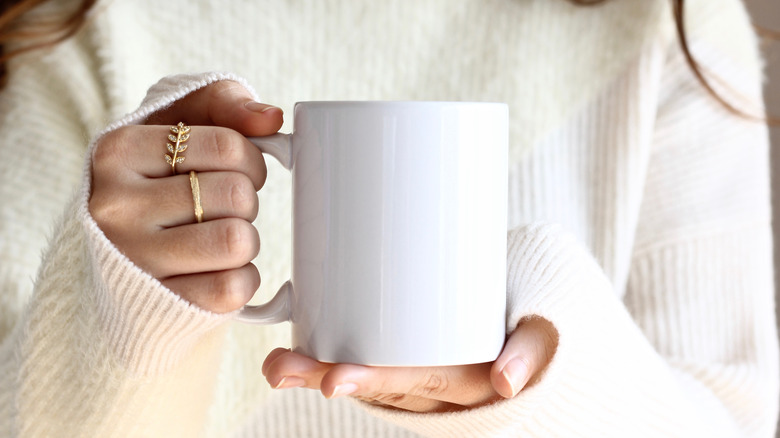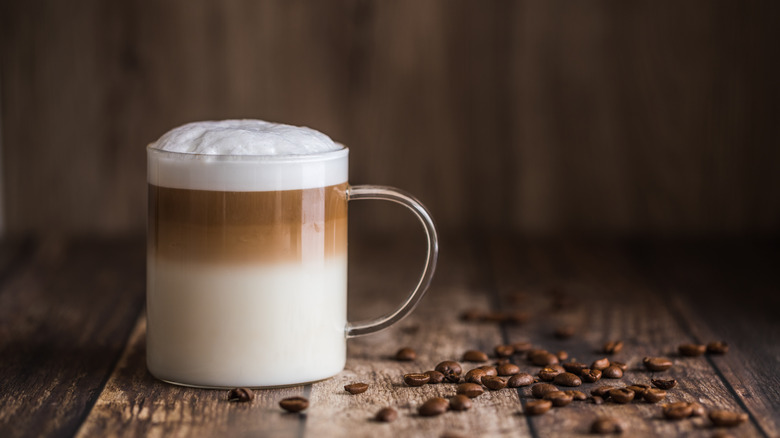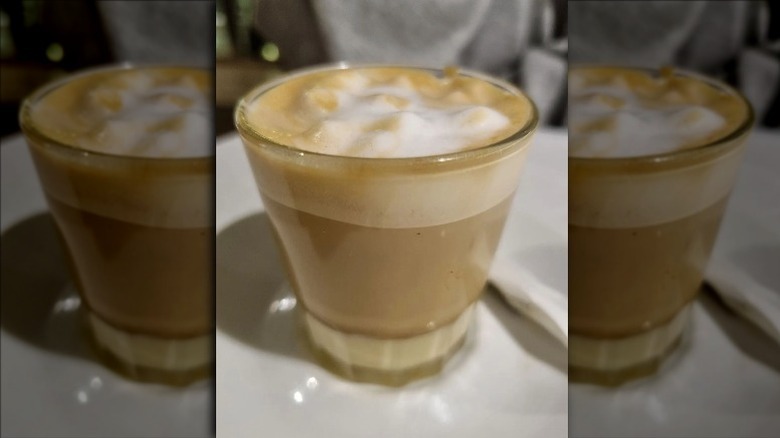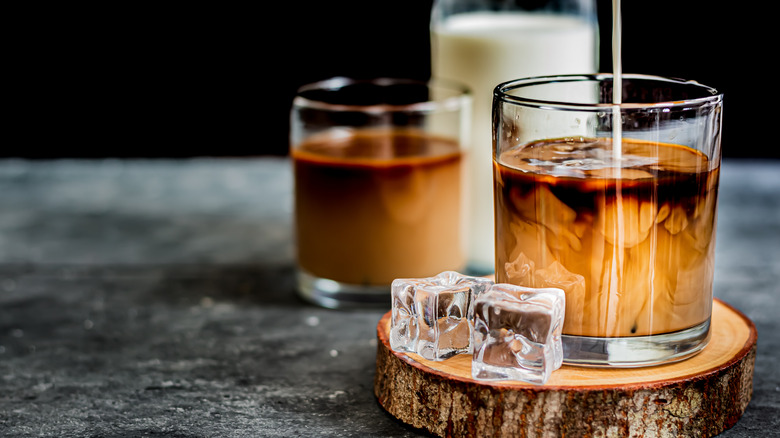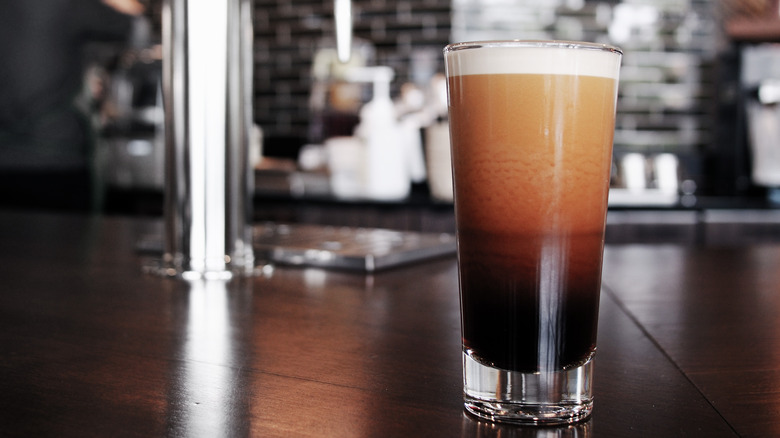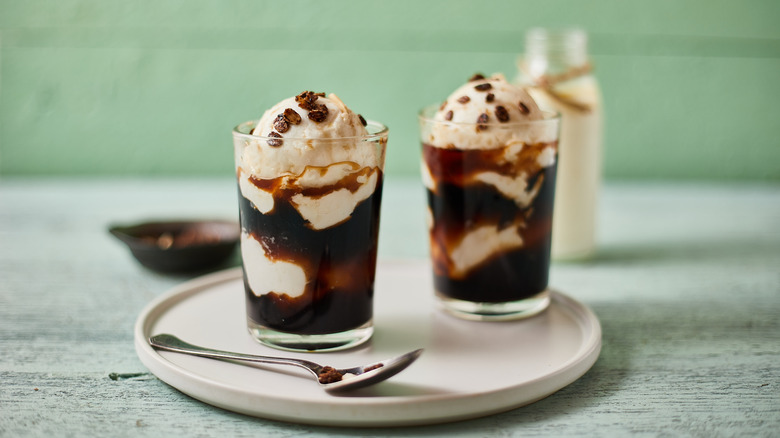Types Of Coffee, Explained
You may know what you're doing when you're ordering at the bar, but what about when you're at a coffee shop? If you're like a lot of people, you have one order and stick to it. You may not even know what goes into that order! There's a whole wide world of coffee to explore, though, and you shouldn't limit yourself to just one or two specific orders. By learning more about the different types of coffee out there, you can ensure that you're always ordering something you love — not just something that gets the job done.
That's why we're reviewing some of the most popular types of coffee orders out there. Read up on these different varieties, and figure out which ones sound best to you. Then, the next time you make your way to a coffee shop, you'll know exactly what you should order. Whether you want to keep things simple with an espresso or an Americano, or you'd rather branch out and try a flat white or a nitro cold brew, knowing what's what at your local coffee shop is sure to win you some points with your barista ... and the perfect caffeine buzz to help you get through your day.
Espresso
One of the most common types of coffee out there is the famous espresso, an Italian invention that continues to be popular in Europe and throughout the world. Not only is it a popular order in and of itself, but it's also used to make plenty of other coffee drinks on a café's menu. Essentially, it's a concentrated shot of coffee. Instead of the full cup of joe you may be used to, an espresso contains just a few swigs of liquid. However, there's a decent amount of caffeine in those swigs: You're looking at up to 100 mg of caffeine per shot of espresso.
Espressos also have a foamy, creamy layer of froth blanketing the rest of the liquid. This is referred to as the crema, and it's one of the reasons espressos are so popular — it gives the drink a touch of creaminess that requires no actual cream whatsoever. This contributes to the long finish espressos tend to offer.
So, how does it differ from plain old coffee? It uses the same beans, which are roasted in the same way. The only difference is in how the beans are processed: Espresso beans are ground more finely than normal coffee beans.
Drip coffee
If your coffee drink isn't espresso-based, it's probably drip coffee. This is the stuff you make at home with your automatic coffee pot, and it's what you're likely to find at diners or anyplace else that serves one-size-fits-all coffee during the morning hours. But what sets it apart from espresso? Basically, it comes down to how it's prepared. While espresso beans are very finely ground, drip coffee beans are ground into larger pieces. It also takes longer to brew a cup of drip coffee than it does to make an espresso, per How Stuff Works.
A drip coffee tends to have around the same amount of caffeine as an espresso, but caffeine content can vary depending on the bean and how strong the coffee shop in question brews its coffee. However, you're going to have to drink a lot more of it for it to give you the same effect as just a single shot of espresso. Drip coffee is a classic, but it usually isn't going to be whipped up into all different kinds of coffee drinks.
Doppio
If you like espresso, there's a good chance you're going to enjoy a doppio even more. In Italian, doppio literally means "double," according to Latte Art Guide, and that's exactly what a doppio is: a double shot of espresso. That means you get two shots of coffee instead of one, and you're looking at double the amount of caffeine. A doppio is a great idea if you know you're going to want two espressos but don't have time to wait at the coffeehouse until you finish your first one.
Of course, you don't have to say "doppio," especially if you're not in Italy. Tell your barista that you want a double shot of espresso, and they'll serve you the same thing. It's also common to add a doppio or a double shot to other coffee drinks to increase the levels of caffeine and make the drink stronger. For those who are looking for an intense caffeine fix, it's hard to beat what a doppio can offer.
Cappuccino
Another super-common coffee beverage is the cappuccino. In fact, there's a good chance that you've ordered a cappuccino or two in your time, even if you didn't know exactly what it was. This is a coffee drink that utilizes an espresso as the base of the beverage, per Drink Trade. Then, foamed milk is added to create a creamy drink that's sometimes confused with a latte. However, with a cappuccino, you're going to get that lovely foam on top. And since you have the crema mixed with the froth from the milk, cappuccinos are super foamy. Oftentimes, if you order a cappuccino at a coffee shop, they'll create a design with all that foam.
Of course, you're free to enjoy a cappuccino at any point in the day — don't let any rules that say otherwise deter you from ordering exactly what you want. But according to Food Republic, most Italians agree that a cappuccino is a beverage to be enjoyed in the morning. If you eat out at a restaurant in Italy and try to order a cappuccino after your dinner instead of an espresso, you might get a weird look.
Americano
No, an Americano is not just a regular coffee served in the U.S., but you could be forgiven for thinking that. In reality, this is another coffee drink that uses espresso as a base. It's as simple as can be: An Americano is simply an espresso combined with hot water, according to Roasty Coffee. Generally, the drink will consist of one-third espresso and two-thirds hot water, but some Americanos are half and half. So, how did the Americano even come to be if the espresso is originally from Italy?
Legend has it that Americans fighting in Italy during World War II weren't too fond of the intensely flavored espresso they found overseas. They couldn't get the coffee they were used to from home, so they made do with what they had and simply added water to their espressos. This method mimicked drip coffee enough that it became a favorite that remains popular to this day. So, if you're ever at a coffee shop that doesn't offer drip coffee and that's what you want, you can feel confident that you'll probably be just as satisfied with an Americano.
Latte
Ever had a hard time choosing between a cappuccino and a latte? You're not alone. They seem remarkably similar, and it's true that they're alike in many ways. According to Starbucks, they both start with a shot of espresso followed by steamed milk with a foamed milk on top. But that's where the similarities end, and the final results don't really taste that similar at all. The milk foam on top of a latte is very thin when compared to the thick, luscious foam you'll find on a cappuccino (and you're not likely to find a barista who's going to try to create a design on the top of your latte). Lattes can be hot or iced.
But what's really important is the taste. With a cappuccino, that espresso flavor is still very pronounced. Even with the inclusion of milk, you're going to get that rich, intense flavor of coffee coming through quite a bit. However, a latte tends to be more mellow in flavor — you'll be able to taste the flavor of the milk quite well. Because of this, it's important to make sure you're choosing a type of milk you actually like. If you don't prefer almond milk but get it in your latte anyway, you're likely to be disappointed with the flavor.
Mocha
Not everyone likes their coffee sweet, but for mocha lovers, there's nothing better than some extra sugar to flavor an otherwise exceptionally bitter drink. So, what exactly is a mocha? It starts out the same way as a latte — the shot of espresso, the steamed milk, the thin layer of foam on top — but it also contains a drizzle of chocolate syrup, per Roasty Coffee. This chocolate doesn't just add sweetness, but it also provides a depth of flavor that some think enhances the taste of the espresso.
A mocha is generally thought of as an indulgent drink, but that doesn't mean it can't be something you enjoy on the regular. The great thing about this drink is the fact that it's highly customizable. If you like your coffee really sweet, you can ask for a generous drizzle of chocolate. However, if you just want to add a little bit of flavor to your drink, feel free to go lighter on the syrup. Either way, you're going to end up with a delicious coffee that's a departure from the norm.
Flat white
It was only 2015 when Starbucks started selling flat whites, according to Vox. Since then, this coffee drink has been all over the American market, and it's emerged as a strong contender amongst similar drinks like lattes and cappuccinos. But what exactly is it? Like these other popular coffee drinks, it's a combination of espresso, steamed milk, and milk foam. However, according to the Paulig Barista Institute, flat whites hail from Australia, unlike most other espresso-based drinks, which come from Italy.
A flat white contains two shots of espresso, which means that it tends to be stronger, both in flavor and in caffeine content, than most cappuccinos and lattes. There's only a little foam in a flat white, so the flavor of the espresso really stands out. A flat white is a great choice for those who want to savor the flavor of their coffee but still want a splash of milk added to the mix.
Red eye
You don't hear about red eyes that often, especially at your average coffee shop. That may be because it could well be considered too strong for most coffee drinkers. But if you've been on a plane all night and you need some energy once you reach your destination, it's clear that this drink is going to give you enough energy to power you for several hours at least. A red eye is a drip coffee with an added shot of espresso, according to Drink Trade. If you're feeling extra tired and want to potentially stay awake for the next week, you can add a double shot.
As wild as a red eye sounds, it's not far off from a cold brew. If you love the intensity and rich flavor of a typical cold brew, then there's a good chance that you'll love a red eye as well. However, it's almost always served hot, so it may not be ideal to order during the depths of summer if you don't want to break out in a caffeine-induced sweat.
Macchiato
While a cappuccino is generally regarded as off-limits for afternoons, the macchiato is not, per Roasty Coffee. It's often thought of as "middle ground" between an espresso and a cappuccino. So while, yes, it does contain steamed milk, it doesn't contain as much milk as a cappuccino, so it's a bit stronger in taste and caffeine. Instead, the dominant flavor is the espresso.
But really, there's not one standard definition of a macchiato, and it can be made different ways. Roasty Coffee breaks macchiatos into two categories: espresso macchiatos and latte macchiatos. When you order this drink, you'll usually get an espresso macchiato. But if you do get a latte macchiato, you'll find yourself with a drink that has even more milk in it than a regular latte. "Macchiato" means "mark," and in the case of a latte macchiato, the espresso is "marking" the milk. Oftentimes, less than a full shot will be used in macchiatos, so you're going to get a milder version of the other espresso-based drinks you already love.
Macchiatos may seem similar to some of the other drinks on this list, but if you order it side by side with other coffee drinks, you'll notice a distinct difference.
Cortado
If you're looking for something simple and straightforward but more interesting than a standard shot of espresso, you may have found exactly what you're looking for in a cortado. This one is easy to remember: It's equal parts espresso and milk, according to Coffee at Three. Wondering how it got its name? In Spanish, "cortado" means "cut." In this case, the steamed milk is cutting the acidity of the espresso for a milder drink. Because you're just using a small amount of milk in this drink, it's likely to come in a tiny cup you would expect to use for an espresso.
While lattes, macchiatos, and cappuccinos are full-size drinks, you're going to get just a sip of a cortado. This makes it a great choice for people who want to get their coffee fix on the go but who can't stand the intense flavor of an espresso all by itself.
Cold brew
Lots of people assume that cold brew coffee is the same thing as iced coffee, but that's not true. Iced coffee is just drip coffee that's been brewed hot and then cooled down and combined with ice. A cold brew, on the other hand, is prepared with cold or room-temperature water. Brewing coffee this way takes longer than traditional drip coffee, but it also results in a sweeter, less acidic, and smoother cup of coffee than you would otherwise expect.
But if you're not used to this kind of coffee, you should be careful before taking a sip. Not only is the flavor different — the caffeine content is too. Cold brew is usually about two to three times as caffeinated as your average drip coffee, which means it can be intense for those who are sensitive to caffeine. If you're looking for the perfect pick-me-up, though, you really can't go wrong with a cold brew.
Nitro cold brew
So what if you already love the intensity and sweetness of cold brew but you want to try something completely new? That's where nitro cold brew comes in. This coffee drink starts out like any average cup of cold brew, but per "Today," it's infused with tiny nitrogen bubbles. Don't worry — it doesn't have a carbonated feel to it. Instead, those little bubbles create a rich, creamy foam on the top of your coffee that somewhat resembles the crema found in espresso. That foaminess leads some to describe the drink as similar to beer, but there are definitely fewer bubbles.
Like regular cold brew, this drink is high in caffeine, so make sure you're okay with that before you order it from your local coffee shop. A few years ago, it was difficult to find nitro cold brew in most coffee shops, but since Starbucks has rolled it out, it's becoming more and more commonplace.
Affogato
Coffee may seem like something you have for breakfast or a drink you enjoy in the middle of the day when you're trying to get over that midday slump. But you don't have to relegate it to the early hours of the day. In fact, why not turn your coffee into a whole dessert? That's exactly the idea behind the affogato. The Perfect Daily Grind tells us that an affogato is a scoop of ice cream with an espresso shot poured over top. The result is a creamy delicacy usually eaten with a spoon that nonetheless serves up a decent dose of caffeine.
You should eat an affogato right after it's prepared, because the shot of espresso can make the ice cream melt very quickly. However, it usually comes out in a small serving anyway, so you shouldn't worry about not being able to finish it. As a sophisticated and fun dessert, it'll make you feel better about ordering that post-dinner scoop of ice cream.
